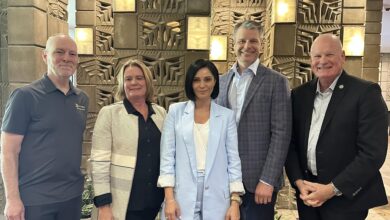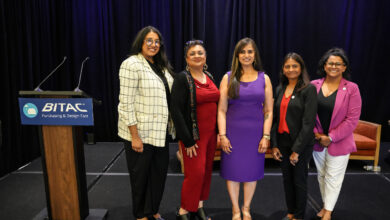
BITAC Owners 2025 Panel: Hotel Repositioning & Renovating, Part 2
By Jim Nelson | June 26, 2025
At Hotel Interactive and sister company BITAC’s 2025 Owners event one of the educational panel discussions shined a spotlight on repositioning and renovating hotels. Our moderator was Purvi Panwala, cofounder of PPM Corporation USA, and her esteemed panelists were Zayn Jasani, senior managing principal of XO Ventures; Neil Shah, the president of Inntech Management; Elliott Estes, a cofounder and principal at Woodmont Lodging; and Martin Thornros, president of Convergence Services.
In part 1 of this article, we learned about the panelists’ decision-making process when choosing between branded or independent repositioning and their most effective financing strategies for repositioning a hotel. Here in part 2, Purvi began by asking whether any of the panelists have used any FF&E financing or do they usually take over an asset and do a large capital stack?

ZAYN JASANI: I think you can add FF&E financing to the stack. [Neil] had a good point: seller financing is something we do look for in distressed properties and you can negotiate some really, really good stuff. Recently, we acquired a property at four percent, but it was negative cash flow, so it was a hold scenario for us, and a conversion play. It was long term, but it ended up being low cash, low capital injection, and it worked out.
ELLIOTT ESTES: Did he provide 100 percent of the debt financing?
ZJ: Ninety percent of the entire acquisition cost.
EE: So, when we end up going back and forth with sellers, the interest rate that was just referenced, all that to me is purchase price, right? The more you have to pay to your lenders, the less you can actually pay to the person that’s selling. So, what I just heard, the person willing to sell the property at a low interest rate sounds like their motivation was a certain amount of proceeds or a certain transaction price. And if that person was to sell to the market to someone like me, I’m going to get a seven and a half to nine percent interest rate, I’m guessing, for a similar deal. Obviously, you ran the numbers, but at those numbers, I would then offer him maybe $2 or $3 million less, or $5 or $10 million less, depending on how big the deal is.
NEIL SHAH: Seller financing can create a real win/win situation for the buyer and the seller, because a lot of times, if the regular income is important for the seller, they don’t really need a large sum of cash, then it works for the buyer, because they can acquire the property for a lot less money down, having to go through all the pain of getting a loan approved by the lender, getting to the finish line; SBA loans are becoming more and more difficult. At the same time, the benefit for the seller is they still get a big chunk of money up front, but at the same time, now they have a regular monthly income coming. Another problem you can solve is when there is a gap between the seller’s expectations of the purchase price and the buyer’s willingness to offer; that gap could be made up in the interest payments you are making over the time. So instead of saying, “I can pay you a price now,” you can say, “I will pay you a price over the time.”
PP: Once you get the asset, you secure it financially, and then the real work begins. When you’re working with a contractor, tell me a little bit about how you’re negotiating with the terms, how you’re making sure that they complete these renovations on time, so that you know you’re not running out of that cash that you got.
ZJ: You have to put performance hurdles and completion hurdles in there and just be very transparent with them. And they have to be very transparent with you about completion timelines. You can’t have cost overruns, etc. But I think you have to hone down; we’re talking about repositions here, specifically, so how many repositions has that GC actually done? There’s a lot of renovation companies, there’s a lot of construction companies out there; I would pick only a general contractor that is focused on conversion plays and rehab, adaptive reuse, whatever they are specifically good at. And I would not go with anyone else, regardless of where their price point comes in, even if it’s $1 million less, I bet their timeline is not on point. I’ve learned the hard way from that.
PP: Definitely get someone that specializes in it. How about you, Elliott?

EE: By the time I’m thinking about a GC contract, I’m worried about scope and termination. We have a small shop, and we leverage a lot of third parties. Specifically, we have a third-party project manager that we’ve worked with almost exclusively for the last eight years. By the time you bid a project out to two or three groups, and you do all the things that you’re supposed to do, you’re going to end up close to the same place, hopefully. And to Zayn’s point, it’s going to come down to relationships and communication, and how do you get through those milestones that [he] referenced, how you do that together?
PP: Okay, let’s get into some of the technology. When budgeting for low voltage and IT infrastructure in a renovation, what’s the rule of thumb for allocating costs, and have lenders or investors pushed back on these line items?
MARTIN THORNROS: We always get pushback. Because a lot of the IT infrastructure and IT services are behind the walls or nonvisible, it’s much easier to convince someone to change carpet than it is to change the Wi-Fi system. From a property perspective, I know which one I think is more important, but I’m kind of biased. In general, it’s obviously critical to have those services in the property, and they have to be done correctly. It’s relatively easy to shave off 25 percent on pretty much any IT bid out there by taking out the part that may not be critical today, but six months down the road, it’s going to cost you — from a total cost of ownership — twice as much instead of doing it right the first time.
PP: In that case, how do you assess which technology upgrades to put in?
MT: The critical side is for the operator to come up with a strategy for what is going to make sense. It’s not just an initial cost; for example, we’re doing a property in Santa Barbara right now that has two weddings a week and they’re spending about three quarters of a million dollars on an audio system. But they’ll be able to rent it twice a week for, well, ever, probably — or until the system needs to be updated, which is probably five, six years. Well, if you have a property that has one wedding a month, you’re never going to make your money back for that. So, there’s a balance between what parts you bring in and what you focus on.






Get involved!
Comments